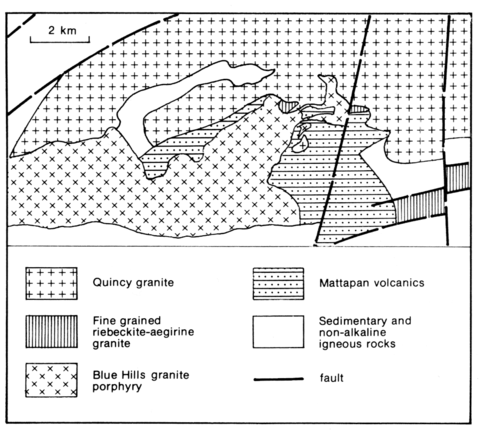stripes
The term 'Quincy Granite' was formerly used as a general term to include other New England peralkaline granites such as the Cape Ann (No. 133) and Peabody (No. 134) granites, but is now more generally restricted to the type area lying south of the town of Quincy. The name Blue Hills complex seems sometimes to be used to refer to the area on the southern side of the Quincy granite formed essentially of the Blue Hills granite porphyry, and at other times as being synonymous with the complex as a whole, including the Quincy granite, e. g. Zartman and Marvin (1971). The Quincy granite complex extends for about 17 km east-west and up to 4 km north-south. The principal rock type over the northern and eastern parts of the complex is the Quincy granite which consists of about 60% microcline microperthite, 30% quartz, 10% riebeckite and aegirine and a range of accessories. On the southern side of the eastern half of the complex the marginal facies is a fine grained riebeckite-aegirine granite mineralogically similar to the Quincy granite. The southwestern part of the complex is occupied by the Blue Hill granite porphyry which intrudes the Quincy granite. The porphyry contains 40-80% phenocrysts, predominantly of perthite, but with some of quartz and riebeckite, in a matrix of the same minerals. Rhyolitic rocks, known as the Mattapan volcanics, cover about 5 km2, principally in the western part of the complex, and consist of ash-flow tuffs and possible lavas. Alteration precludes determination of the primary mafic mineralogy. Chemical analyses of Quincy granite will be found in Emerson (1917, p. 191) and a range of trace elements of rocks and minerals in Buma et al. (1971).
BOTTINO, M.L., FULLAGAR, P.D., FAIRBAIRN, H.W., PINSON, W.H. and HURLEY, P.M. 1970. The Blue Hills igneous complex, Massachusetts: whole-rock Rb-Sr open systems. Bulletin of the Geological Society of America, 81: 3739-46.
BUMA, G., FREY, F.A. and WONES, D.R. 1971. New England granites: trace element evidence regarding their origin and differentiation. Contributions to MIneralogy and Petrology, 31: 300-20.
CHUTE, N.E. 1969. Bedrock geologic map of the Blue Hills Quadrangle, Norfolk, Suffolk, and Plymouth Counties, Massachusetts. 1:24,000. United States Geological Survey, Map GQ-796.
EMERSON, B.K. 1917. Geology of Massachusetts and Rhode Island. Bulletin, United States Geological Survey, 597: 1-289.
LYONS, P.C. and KRUEGER, H.W. 1976. Petrology, chemistry, and age of the Rattlesnake pluton and implications for other alkalic granite plutons of southern New England. Memoir, Geological Society of America, 146: 71-102.
ZARTMAN, R.E. and MARVIN, R.F. 1971. Radiometric age (late Ordovician) of the Quincy, Cape Ann, and Peabody granites from eastern Massachusetts. Bulletin of the Geological Society of America, 82: 937-57

